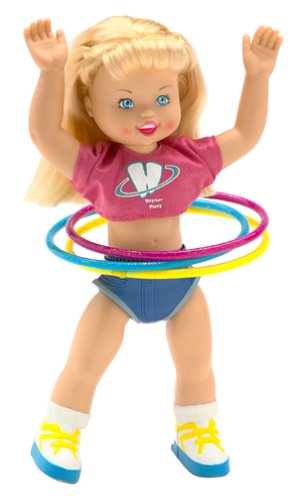Electronic Hula Heather
Hula Hoop Doll.
 She moves and does the hula hoop. Great toy for an active girl.
She moves and does the hula hoop. Great toy for an active girl.
History of Hula Hooping
Hula hooping, a beloved pastime that involves twirling a large hoop around the waist and hips, has a rich history that spans cultures and generations. Here's a journey through the evolution of hula hooping:
Ancient Roots: The concept of hula hooping can be traced back to ancient civilizations. In ancient Greece, children played with hoops made from grapevines, while Egyptian tomb paintings depict individuals engaging in similar activities with hoops made from various materials.
Traditional Practices: Indigenous cultures, such as Native American tribes, practiced hoop dancing as part of their traditions. These dances involved intricate and skillful manipulation of hoops to tell stories and express cultural significance.
Wham-O's Innovation: The modern hula hoop craze began in the late 1950s. Richard Knerr and Arthur "Spud" Melin, founders of the toy company Wham-O, introduced the plastic hula hoop to the American market in 1958. They were inspired by Australian children who played with bamboo hoops.
Mass Phenomenon: The hula hoop quickly became a cultural sensation. Wham-O sold over 100 million hula hoops within the first few years of its introduction. The toy's popularity was fueled by media coverage, celebrity endorsements, and hula hooping contests.
Diverse Audience: Hula hooping was embraced by people of all ages. Children, teenagers, and adults alike joined in the craze, enjoying the rhythmic motion and physical activity associated with the activity.
Iconic Symbol: The hula hoop became an icon of the 1950s and early 1960s, symbolizing the carefree spirit and enthusiasm of the era. It was featured in movies, TV shows, and advertisements, cementing its place in pop culture.
Evolution and Variations: As the hula hoop trend evolved, people experimented with different materials, sizes, and designs. The introduction of weighted and collapsible hoops allowed for more complex tricks and performances.
Hula Hooping Revival: While the initial craze subsided, hula hooping experienced a revival in the 1990s and early 2000s as a fitness and dance activity. People discovered its benefits for cardiovascular exercise, core strength, and coordination.
Artistic Expression: Hula hooping also found a place in the realm of performing arts. Contemporary hoop dancers incorporated colorful and illuminated hoops into their routines, creating mesmerizing visual displays at festivals and events.
Modern Day: Hula hooping remains a popular recreational activity, fitness routine, and artistic form of expression. It has evolved to include hoop dance, hoop fitness classes, and even hoop yoga, demonstrating its versatility and adaptability.
The history of hula hooping showcases how a simple toy can capture the imagination and enthusiasm of multiple generations. From its ancient origins to its place in modern fitness and art, hula hooping continues to bring joy, movement, and creativity to people around the world.
